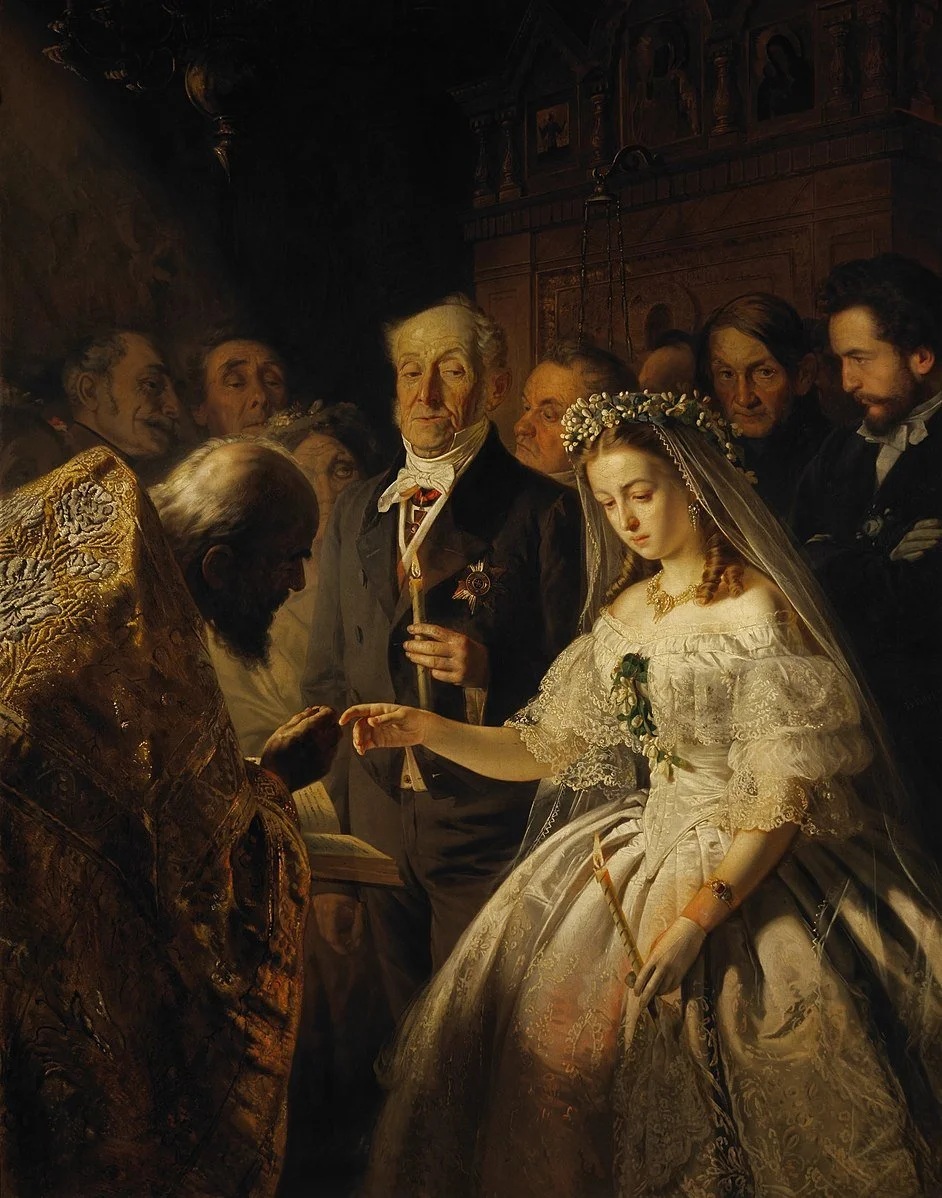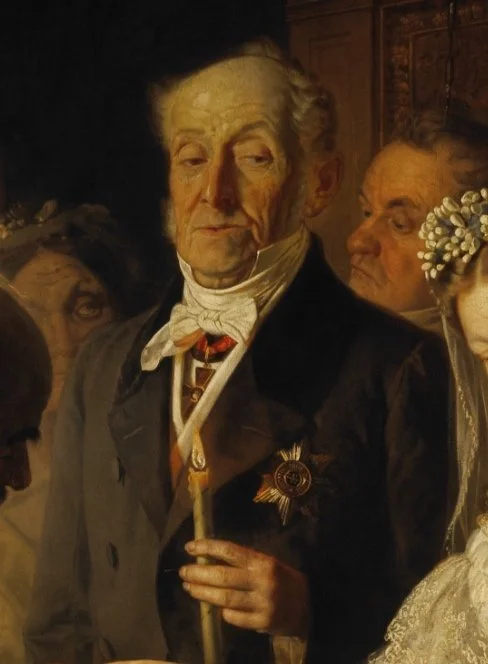Behind the Painting: The Unequal Marriage
Vasili Vladimirovich Pukirev, The Unequal Marriage, 1862. Image from Wikimedia Commons.
"The Unequal Marriage" is a notable oil painting by Vasili Vladimirovich Pukirev, a Russian artist who gained prominence in the 19th century. Created in 1862, this painting is widely recognized for its poignant portrayal of a marriage ceremony characterized by a stark contrast between the bride and the groom. Pukirev’s work not only reflects his artistic prowess but also offers a critical commentary on the societal norms and issues of his time. This analysis aims to provide a comprehensive examination of the painting, covering its visual aspects, the background of the artist, details about the subjects depicted, the historical context, and the symbolic meanings embedded within the artwork.
The Painting
"The Unequal Marriage" is set within the confines of a dimly lit church, capturing the solemn moment of a marriage ceremony. The central figures are a young bride and an elderly groom, whose stark differences in age and demeanor are immediately apparent. The bride, Praskovya Matveevna Varentsona, stands to the Right with her hand extended, dressed in a traditional white wedding gown and a veil. Her face tilted down towards the floor with a somber expression, in her hand, a lit candle. In stark contrast, the groom, an older stern looking man, stands to the Left, dressed in formal attire with a medal adorning his chest, a matching candle in hand, gaze towards his bride to be.
Surrounding the couple are various attendants and onlookers, whose expressions range from indifference to curiosity. The priest officiating the ceremony stands on the left of the painting, interacting with the young bride, his face mostly obscured by shadows, adding to the overall gravity of the scene.
Provenance
Following its debut at the 1862 academic exhibition, "The Unequal Marriage" was acquired by Pavel Tretyakov, the renowned art collector and founder of the State Tretyakov Gallery in Moscow. The painting has remained a part of the gallery's permanent collection since then, cementing its place in the canon of Russian art.
Over the years, "The Unequal Marriage" has been featured in numerous exhibitions both within Russia and internationally. It has been loaned to major museums around the world, including the Musée d'Orsay in Paris and the National Gallery in London, for special exhibitions on Russian realist painting.
Today, visitors to the State Tretyakov Gallery can view this masterpiece alongside other important works of 19th-century Russian art. Its prominent placement within the museum underscores its significance in the history of Russian painting and its continued ability to captivate audiences.
The Artist
Vasili Vladimirovich Pukirev, Self-Portrait, 1868. Russian Museum, Saint-Petersburg, Russia.
Vasili Vladimirovich Pukirev (1832-1890) was a Russian painter known for his realist style and keen observations of societal themes. Born into a poor peasant family, Pukirev's entry into the world of art was serendipitous. A fortunate coincidence allowed him to enroll in the Moscow School of Painting, Sculpture, and Architecture. In 1858, Pukirev graduated with the title of a “free artist,” and two years later, the Imperial Academy of Painting awarded him the title of academician of historical and portrait painting. This recognition came with a state-owned apartment and a teaching position, reflecting his esteemed status in the art community.
In 1862, at the age of 30, Pukirev presented his painting "The Unequal Marriage" at the annual academic exhibition, which caused a great sensation. This work, depicting the societal issue of arranged marriages, earned him widespread acclaim and the title of professor. Despite this success, the further fate of Pukirev's career is tinged with melancholy. None of his subsequent paintings achieved the same level of recognition, leading many to regard him as “the artist of one painting.” Nevertheless, Pukirev continued to explore various creative avenues, painting scenes of Moscow, provincial temples, churches, and icons, while also dedicating himself to teaching.
Pukirev's ability to convey human emotions and social issues through his works remains a significant aspect of his legacy. His most famous painting, "The Unequal Marriage," illustrates his talent for highlighting the complexities and injustices inherent in 19th-century Russian society. Through this work, Pukirev captured the stark contrasts and tensions of his time, solidifying his place in the history of Russian art. Despite the overshadowing success of this singular masterpiece, Pukirev's contributions to art and his efforts to address societal themes continue to be remembered and appreciated.
Subjects: The Bride and The Groom
Vasilii Pukirev's painting "The Unequal Marriage" is often seen through the lens of his personal experience. There are two varying narratives as to the identity of the individuals depicted in this painting.
According to one interpretation, It is possible the bride is a young woman called Praskovia Matveevna Varentsova. In 2002, the Tretyakov Gallery acquired a pencil drawing made by Vladimir Sukhov in 1907, signed: "Praskovia Matveevna Varentsova, whose likeness 44 years ago took the artist V. Pukirev while creating his famous painting Unequal Marriage. Mrs. Varentsova lives in Moscow, in the Mazurin poorhouse." Suggesting Pukirev himself fell deeply in love with Praskovia Matveevna, a beautiful young woman destined to marry a wealthy merchant named Varentsov. Despite Pukirev's affection, Praskovia's marriage to Varentsov proceeded, leaving her without the happiness or wealth she might have hoped for. Her later life, as evidenced by a portrait in a poorhouse, suggests a fate colored by disappointment and hardship rather than fulfillment.
Another narrative surrounding "The Unequal Marriage" involves Pukirev's friend Sergei Varentsov, who faced a similar ordeal of unrequited love. Sergei's affection for Sofia Rybnikova went unreciprocated as she chose to marry Andrei Karzinkin, a wealthier and older suitor. Despite the emotional turmoil caused by this rejection, Sergei found himself compelled to play a significant role at Sofia's wedding, portrayed metaphorically behind her in the painting. This depiction, influenced by Sergei's experiences, prompted Pukirev to initially immortalize his friend's anguish in the artwork.
Over time, as circumstances changed and tensions eased, Varentsov raised objections to Pukirev's portrayal, leading the artist to modify the painting. Pukirev, drawing from his own and Sergei's shared emotional landscape, eventually placed himself behind the bride, symbolically aligning his own sentiments with those expressed in the artwork. This reinterpretation reflected the realization that Sofia's marriage, unlike the painting's title suggests, was ultimately a happy and fulfilling union. Thus, "The Unequal Marriage" not only captures the personal dramas of its subjects but also mirrors the complex interplay of love, disappointment, and artistic expression in Pukirev's life and era.
Symbolism and Meaning
The painting brims with symbolism that enriches its narrative, such as:
The Bride’s Expression: Her head is bowed, likely the only way she can express her dissatisfaction with the marriage. Her eyes are swollen and reddened, suggesting she has either recently cried or is on the verge of tears.
The Bride: The bride appears distinctly youthful, exuding innocence and youthfulness, depicted with softer hues compared to the other figures in the painting. Could symbolize her role as a victim of societal norms and expectations regarding marriage.
Bride’s Candle: The Bride limply holds a candle, wax dripping on her dress, showing such bitterness and sadness about the ceremony.
Outstretched Hand: The Bride’s right hand is extended towards the priest as the wedding ring is being brought to her hand by the priest, seemingly an acceptance or indifference to her fate.
The Groom’s Expression: His head remains rigid against the high collar, with dull eyes gazing haughtily at the bride.
The Groom’s Attire: He wears an expensive suit and maintains a very rigid posture, possibly indicating the use of a girdle or corset beneath his clothing. His attire clearly suggests wealth.
Order of Saint Vladimir: The Groom displays the Order of Saint Vladimir on his jacket, signifying his extensive civil and military service and indicating his respected status. However, such awards are clearly out of place at a church wedding. This could indicate the groom is viewing the bride from the lofty position of his general’s rank, a clear abuse of power.
Man on the Right: Amongst the observers of the ceremony there is one man seemingly showing displeasure with the marriage. He appears to resemble that of the artist himself, Vasili Pukirev.
Priest: The priest is hunched over and cast in shadow—perhaps the artist is implying a form of divine condemnation of the union.
Two Women: In the background of the ceremony, amongst the observers, is two older women (one behind the groom to the left, and the other on the far left barely visible behind the priest) who don wreaths similar to that of the bride, with one of the women seen in a white cloth. The woman barely visible is near the priest, an unusual placement as ordinary guests aren’t permitted to stand next to the priest during the ceremony. This could suggest these women aren’t physically there but rather depiction of the dead ex-wives of the groom.
Composition: Pukirev guides the viewer's eye through the painting using the placement of figures and the direction of their gazes. The central triangle formed by the bride, groom, and priest creates a sense of tension and unease, reflecting the emotional undercurrents of the scene.
Reception and Influence
"The Unequal Marriage" caused a sensation when it was first exhibited at the annual academic exhibition in 1862. Critics and the public alike were struck by its powerful social commentary and emotional depth. The painting's stark portrayal of the inequality in arranged marriages resonated deeply with viewers, sparking discussions about societal norms and the treatment of young women.
The work's impact extended beyond its initial reception, influencing the broader movement of social realism in Russian art. Pukirev's unflinching examination of social issues paved the way for other artists to address similar themes in their work. Artists like Ilya Repin and Vladimir Makovsky would later create works that echoed Pukirev's commitment to exposing societal injustices through art.
Conclusion
"The Unequal Marriage" by Vasili Vladimirovich Pukirev stands as a powerful critique of 19th-century Russian society, particularly the practice of arranged marriages between young women and older, wealthy men. Through his masterful use of symbolism, composition, and emotional portrayal, Pukirev created a work that resonates far beyond its immediate context.
The painting's enduring relevance lies in its ability to evoke empathy for the young bride's plight while simultaneously condemning the societal norms that facilitate such unions. By incorporating elements like the somber church setting, the contrasting expressions of the bride and groom, and the symbolic placement of observers, Pukirev invites viewers to reflect on the human cost of social inequalities and the commodification of marriage.
While "The Unequal Marriage" is firmly rooted in 19th-century Russian society, its themes continue to resonate in modern discussions about marriage, power dynamics, and societal expectations. The painting serves as a historical touchstone for contemporary debates on issues such as:
Age disparities in relationships
Economic motivations in marriage
Women's autonomy and choice in partnerships
The role of tradition and religion in marriage ceremonies
These ongoing conversations demonstrate the enduring relevance of Pukirev's masterpiece and its ability to provoke thought and discussion across generations.







